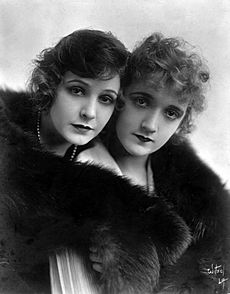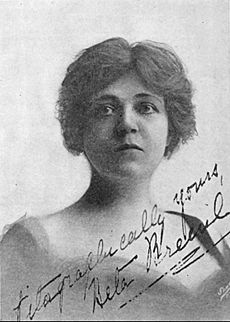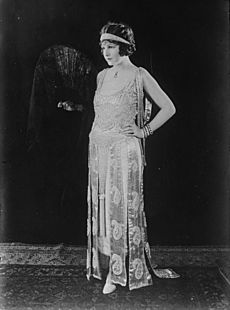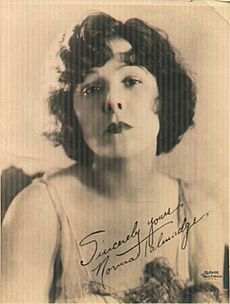Norma Talmadge facts for kids
Quick facts for kids
Norma Talmadge
|
|
|---|---|
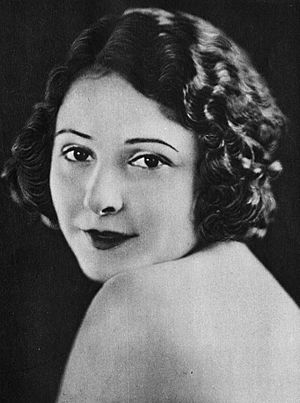
Talmadge in 1920
|
|
| Born |
Norma Marie Talmadge
May 2, 1894 Jersey City, New Jersey, U.S.
|
| Died | December 24, 1957 (aged 63) Las Vegas, Nevada, U.S.
|
| Resting place | Hollywood Forever Cemetery |
| Occupation |
|
| Years active | 1909–1930 |
| Spouse(s) |
Joseph M. Schenck
(m. 1916; div. 1934)Carvel James
(m. 1946) |
| Relatives | Natalie Talmadge (sister) Constance Talmadge (sister) |
| Signature | |
Norma Marie Talmadge (born May 2, 1894 – died December 24, 1957) was an American actress and film producer. She was a huge star during the silent film era. For more than ten years, she was one of the most popular movie stars in America, especially in the early 1920s.
Norma was known for her dramatic movies, called melodramas. Her most famous film was Smilin’ Through (1922). She also made great movies with director Frank Borzage, like Secrets (1924) and The Lady (1925). Her younger sister, Constance Talmadge, was also a movie star. Norma married a rich film producer named Joseph M. Schenck. Together, they successfully started their own movie company. After becoming famous on the East Coast, she moved to Hollywood in 1922.
Norma Talmadge was one of the most stylish and dazzling movie stars of the 1920s. However, as the silent film era ended, her popularity began to fade. After her first two "talkie" films (movies with sound) did not do well, she decided to retire. She was still a very wealthy woman.
Contents
Early Life and Family
Norma Talmadge was born on May 2, 1894, in Jersey City, New Jersey. For a long time, people thought she was born in Niagara Falls, New York. But after she became famous, Norma admitted that she and her mother made up the Niagara Falls story to sound more romantic.
Norma was the oldest daughter of Frederick O. Talmadge and Margaret "Peg" Talmadge. She had two younger sisters, Natalie and Constance. Both of her sisters also became actresses.
Norma and her sisters grew up in poverty. One Christmas morning, their father, Fred Talmadge, left to buy food and never came back. This left their mother, Peg, to raise the three girls alone. Peg worked hard to support her daughters. She took in laundry, sold makeup, taught painting, and rented out rooms in their home in Brooklyn, New York.
One day, Norma told her mother about a classmate who modeled for "illustrated song slides." These were pictures shown in movie theaters before films, so the audience could sing along. Mrs. Talmadge decided to find the photographer. She set up an interview for Norma. After being turned down at first, Norma was soon hired. When they saw Norma's first work in the theater, Peg decided she wanted to get her into motion pictures.
Becoming a Movie Star
First Steps in Film
Norma Talmadge was the oldest sister, and her mother pushed her first to become a film actress. Norma and her mother went to Vitagraph Studios in Flatbush, New York. It was just a streetcar ride from their home. They managed to get past the studio gates and see the casting director. He quickly sent them away.
However, Beta Breuil, a story editor, noticed Norma's beauty. She arranged a small part for Norma in a film called The Household Pest (1909). In this movie, Norma played a young girl who is kissed under a photographer's cloth.
Thanks to Breuil's help, Norma played small parts in over 100 films between 1911 and 1912. She eventually earned a regular job at the studio, making $25 a week. Her first role as a contract actress was in Neighboring Kingdom (1911), with comedian John Bunny.
Her first real success came with Vitagraph's film A Tale of Two Cities (1911). She played a small role as a seamstress. With help from the studio's big star, Maurice Costello, Norma's acting got much better. She continued to play many different characters, from lead roles to extras. This helped her gain experience and become known to the public. By 1913, she was Vitagraph's most promising young actress.
In 1915, Norma got a big opportunity. She starred in Vitagraph's important film The Battle Cry of Peace. This was a drama against Germany. But her ambitious mother, Peg, saw that Norma could achieve even more. She got Norma a two-year contract with National Pictures Company. Norma would make eight films for $400 a week.
Norma's last film for Vitagraph was The Crown Prince's Double. In the summer of 1915, she left Vitagraph. In the five years she had been there, she made over 250 films!
In August, the Talmadge family moved to California. Norma's first role there was in Captivating Mary Carstairs. But this movie was a disaster. The sets and costumes were cheap, and the studio did not have enough money. The film failed, and the small new studio closed down after it was released.
This left the family stuck in California after making only one movie. They decided to aim high and went to Triangle Film Corporation. D. W. Griffith was in charge of productions there. Because of her work in The Battle Cry, Norma got a contract with Griffith's Fine Arts Company. For eight months, she starred in seven films for Triangle. This included the comedy The Social Secretary (1916). In this film, she disguised her beauty as a girl trying to avoid unwanted attention from her male bosses.
Norma Talmadge Film Company
When her contract ended, the Talmadge family returned to New York. At a party, Norma met Broadway and film producer Joseph M. Schenck. He was a rich businessman who wanted to make his own films. Schenck was immediately impressed by Norma. He asked her to marry him and suggested they start a film studio together. Two months later, on October 20, 1916, they were married. Norma called her much older husband "Daddy." He worked with her mother to guide and support her career.
In 1917, Norma and Joseph formed the Norma Talmadge Film Corporation. This company became very successful. Schenck promised he would make his wife the greatest star ever. She would have the best stories, most beautiful costumes, grandest sets, talented actors, and famous directors. She would also get amazing publicity. Soon, women all over the world wanted to be like the romantic Norma Talmadge. They flocked to see her lavish movies, which were filmed on the East Coast.
Schenck soon had many stars working at his studio in New York. The Norma Talmadge Film Corporation made dramas on the first floor. The Constance Talmadge Film Corporation made comedies on the second floor. And the comedy unit, with Roscoe "Fatty" Arbuckle, was on the top floor. Natalie Talmadge worked as a secretary and sometimes played small roles in her sisters' films.
Norma's first film for her own studio was Panthea (1917). This film is now lost. It was directed by Allan Dwan. The movie was a powerful drama for Norma. It was about a woman in Russia who sacrifices herself to help her husband. The film was a big hit. It made Norma a sensation and showed she was a top dramatic actress.
Norma's acting skills quickly improved during this time. She made four to six films a year in New York between 1917 and 1921. Under Schenck's guidance, other films followed. These included Poppy (1917), where she acted with Eugene O'Brien. They were such a popular pair that they made 10 more films together.
In 1918, she worked again with director Sidney Franklin. He directed The Safety Curtain, Her Only Way, Forbidden City, The Heart of Wetona, and The Probation Wife (1919). These films had small settings and often featured the same actors. Being on the East Coast also meant she could work with the country's best fashion designers. Between 1919 and 1920, Norma Talmadge wrote a regular fashion advice column for Photoplay magazine.
Hollywood Success
Throughout the 1920s, Norma continued to succeed in films. These included Yes or No (1920), The Branded Woman, Passion Flower (1921), and The Sign on the Door (1921). The next year, she had the most popular film of her entire career: Smilin' Through (1922). It was directed by Sidney Franklin. This was one of the greatest romantic films of the silent era. It was even remade twice later on.
After Smilin' Through, Schenck closed the New York studios. Norma and Constance moved to Hollywood to join their sister Natalie. Norma's Hollywood films were different from her New York ones. They were bigger and more glamorous. She made fewer films, but they were more varied, often set in different time periods or exotic places. She worked with top cinematographers and costume designers to create a more glamorous image. She also worked with excellent directors like Frank Lloyd, Clarence Brown, and Frank Borzage. With help from her first husband, Joseph M. Schenck, she became one of the highest-paid actresses of the 1920s.
In 1923, a survey of movie theater owners named Norma Talmadge the number-one box office star. She was earning $10,000 a week! She also received as many as 3,000 letters from her fans every week. Her film Secrets (1924), directed by Frank Borzage, was the peak of her career. She gave her best performance in this movie and received excellent reviews.
In 1924, Schenck became the head of United Artists. But Norma still had a contract with First National. She continued to make successful films like The Lady (1925), directed by Frank Borzage. She also made the romantic comedy Kiki (1926), directed by Clarence Brown. This film was later remade by Mary Pickford as a sound film in 1931.
Norma Talmadge and Anna May Wong helped break ground for Grauman's Chinese Theatre on January 5, 1926. They used a gold-plated shovel! The theater's official story says that Norma inspired the tradition of putting footprints in concrete. This happened when she accidentally stepped into wet concrete. However, Sid Grauman, the theater owner, told a different story in 1937. He said he accidentally stepped in wet concrete himself and then asked Mary Pickford to put her foot in it.
Later Career and Retirement
Norma Talmadge's last film for First National was Camille (1926). This movie was based on a famous novel and was later remade by Greta Garbo. During the filming, Norma fell in love with her leading man, Gilbert Roland.
By the time her film Woman Disputed (1928) was released, the talking film revolution had begun. Norma started taking voice lessons to prepare. She worked hard with voice coaches for over a year. Her first talkie, New York Nights (1929), showed that she could speak and act well in sound films. While her acting was considered good, the film itself was not.
Norma then took on the role of Madame du Barry in the 1930 film Du Barry, Woman of Passion. The direction was not good, and Norma was new to roles that needed very strong vocal acting. The film was a failure, even with its fancy sets.
On March 29, 1928, Norma Talmadge, Mary Pickford, Douglas Fairbanks, Charlie Chaplin, Gloria Swanson, John Barrymore, Dolores del Río, and D.W. Griffith all spoke on a radio show. This was to show that Griffith could make talking movies.
Norma's sister Constance sent her a telegram with some advice: "Quit pressing your luck, baby. The critics can't knock those trust funds Mama set up for us." As time went on, it became clear that the public was no longer interested in the old silent film stars. Norma was seen as a star from the past. Norma had already been getting bored with filmmaking before the challenge of talkies came along. This setback seemed to discourage her from trying further.
She still had two more films left on her contract. In late 1930, Samuel Goldwyn announced he had bought the rights to a play for her. She reportedly did some rehearsals for it in New York. But within a few months, she asked to be released from her contract. She never appeared on screen again.
Life After Movies
After leaving the movie world, Norma Talmadge let go of all the duties of being a star. When eager fans asked her for an autograph as she left a restaurant, she famously said, "Get away, dears. I don't need you anymore and you don't need me."
Norma and her first husband, Joseph Schenck, had been separated for seven years. In April 1934, he finally granted her a divorce. Nine days later, she married comedian George Jessel. Schenck continued to help Norma and her sisters, giving them financial advice.
Norma's last professional work was appearing on Jessel's radio program. The show soon ended, and her marriage to Jessel did not last. They divorced in 1939. Thanks to Schenck's business skills and her mother's ambition, Norma had a huge fortune. She never had to worry about money.
After her filmmaking days ended, Norma felt restless. She traveled often, moving between her houses, entertaining, and visiting her sisters. In 1946, she married Dr. Carvel James, a doctor from Beverly Hills.
Later Years and Legacy
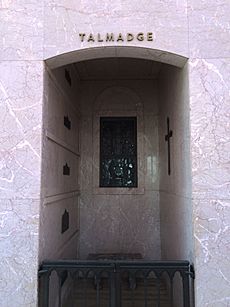
In her later years, Norma Talmadge became very private. She had never been comfortable with the pressures of being a public celebrity. She suffered from painful arthritis. Because of this, she moved to the warm climate of Las Vegas for her final years. In 1956, her fellow actors voted her one of the top five female stars from before 1925. But she was too ill to travel to accept her award.
After having several strokes in 1957, Norma Talmadge died of pneumonia on Christmas Eve of that year. At the time of her death, her fortune was worth over $1,000,000. She is buried with her sisters, Constance and Natalie, in the Abbey of the Psalms at the Hollywood Forever Cemetery.
For her important work in the movie industry, Norma Talmadge has a star on the Hollywood Walk of Fame at 1500 Vine Street.
Talmadge Street in the Los Feliz neighborhood of Los Angeles is named after her. Also, the community of Talmadge, San Diego is named for her and her sisters. One of the streets in that community is named Norma in her honor.
Images for kids
See also
 In Spanish: Norma Talmadge para niños
In Spanish: Norma Talmadge para niños


